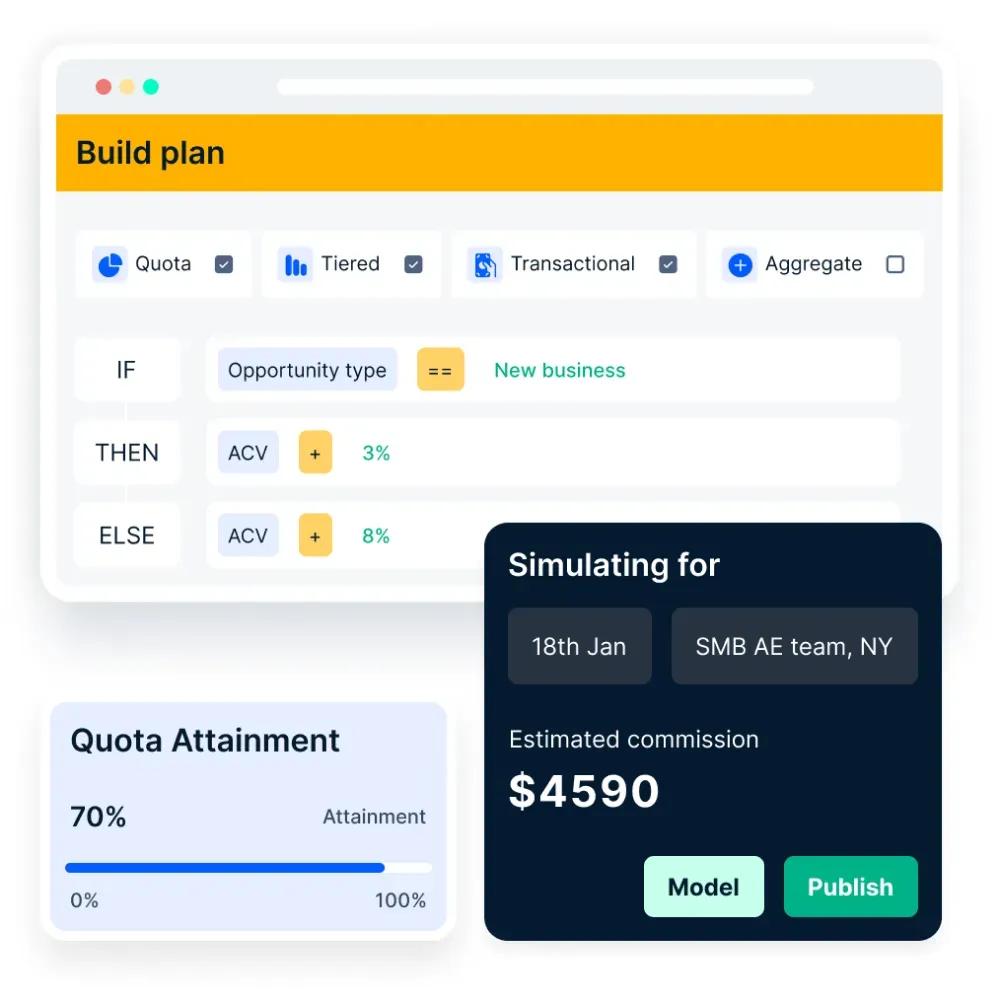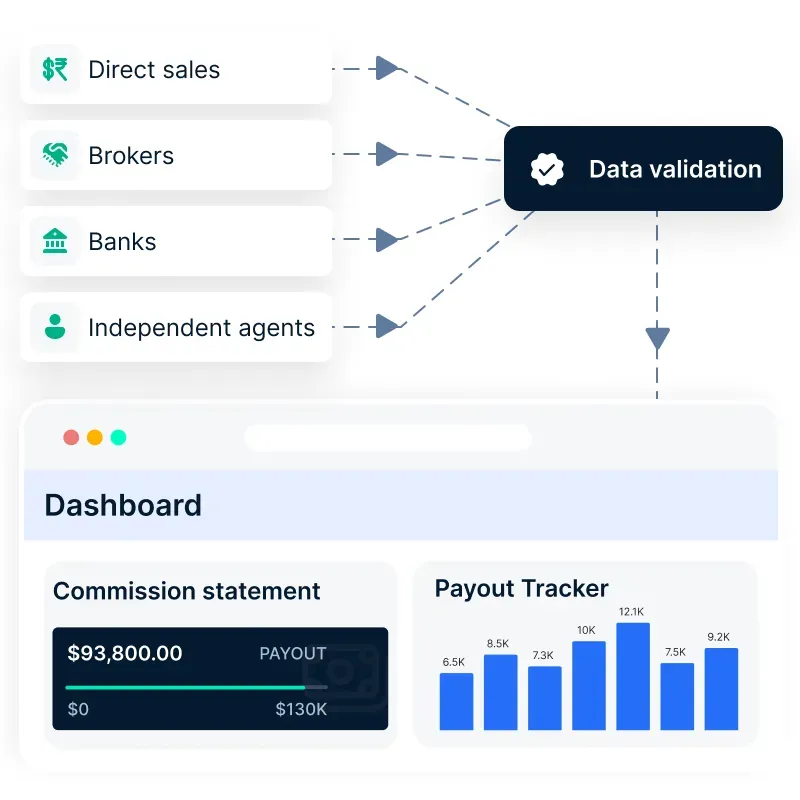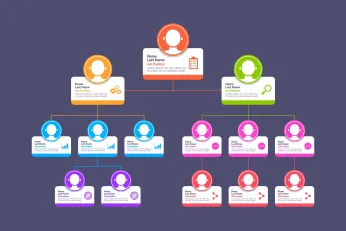Le migliori pratiche di incentivazione delle vendite per la crescita
Imparate le migliori pratiche di compensazione degli incentivi alle vendite per progettare piani di incentivazione efficaci, che spingano le prestazioni di vendita, migliorino la motivazione e massimizzino il ROI per un successo aziendale sostenibile.
In questa pagina
Un programma di incentivi alle vendite ben strutturato è uno strumento potente per favorire la crescita dei ricavi e migliorare le prestazioni dei team di vendita. Se progettati in modo efficace, questi programmi allineano i comportamenti di vendita con gli obiettivi aziendali, motivando i rappresentanti a superare gli obiettivi e garantendo la redditività a lungo termine. Tuttavia, la semplice offerta di incentivi non è sufficiente: seguire le best practice dei programmi di incentivazione delle vendite è fondamentale per mantenere il coinvolgimento e la produttività.
Le aziende che implementano le best practice nella progettazione dei piani di incentivazione delle vendite creano strutture di retribuzione trasparenti e basate sui dati, che premiano le prestazioni elevate e promuovono una crescita sostenibile delle vendite. Le ricerche dimostrano che team di vendita impegnati e motivati contribuiscono ad aumentare la redditività e a ridurre il turnover, rendendo la pianificazione strategica degli incentivi una necessità aziendale. In questo blog verranno descritte le migliori pratiche per la pianificazione e la retribuzione degli incentivi alle vendite.
Che cos'è un compenso per incentivi alle vendite?
I compensi per incentivi sono denaro aggiuntivoI rappresentanti guadagnano, oltre al normale stipendio base e ai bonus, ogni volta che concludono un affare o raggiungono un obiettivo commerciale specifico.
Un rappresentante potrebbe guadagnare una commissione o un bonus, ma nella maggior parte dei casi questo viene distribuito in contanti e fa parte del piano di remunerazione esistente.
D'altra parte, i compensi perincentivi alle venditeè concepito per stimolare determinati comportamenti nei team di vendita, il che consente indubbiamente di aumentare le vendite e funge da strumento di motivazione e riconoscimento.
Ha un valore intrinseco che va oltre il valore monetario. I destinatari vedono questo compenso come una celebrazione, con un senso di apprezzamento e riconoscimento che li rende più memorabili.
L'incentivo può assumere diverse forme e può includere ricompense non in denaro come premi, biglietti, pacchetti vacanza annuali per la famiglia, vacanze di gruppo, ecc. Con un piano di incentivi alle vendite correttamente progettato e realizzato, i venditori massimizzano i loro compensi e l'organizzazione massimizza i ricavi.
Il miglior piano di incentivi alle vendite per la vostra organizzazione deve essere abbastanza semplice da permettere ai rappresentanti di capirne il funzionamento, in modo da intraprendere le azioni necessarie per raggiungere i loro obiettivi.
Come funziona la gestione dei compensi incentivanti?
La gestione dei compensi incentivanti automatizza il calcolo delle commissioni e dei bonus, fornendo ai rappresentanti di vendita un monitoraggio in tempo reale dei guadagni e dei pagamenti. Il sistema giusto semplifica l'amministrazione del piano, rendendo agevoli gli aggiornamenti e le modifiche.
Per un'attuazione efficace, i programmi di incentivazione devono essere allineati agli obiettivi aziendali e alle strategie di vendita. Un piano ben progettato garantisce che la retribuzione variabile rifletta le prestazioni, stimolando la motivazione e i risultati. L'integrazione di questo software con un CRM per le vendite aumenta la visibilità, aiutando i rappresentanti a comprendere i loro guadagni e le metriche di performance.
La gestione manuale dei compensi incentivanti è complessa e soggetta a errori, con conseguenti errori di calcolo, ritardi nei pagamenti e disimpegno dei team di vendita. Compass automatizza l'intero processo di gestione dei compensi incentivanti (ICM), garantendo un monitoraggio in tempo reale, pagamenti accurati e un'amministrazione del piano senza soluzione di continuità.

Con la piattaforma no-code di Compass, le aziende possono progettare, pubblicare e gestire piani di incentivazione per qualsiasi ruolo senza richiedere competenze tecniche. Inoltre, i flussi di lavoro di approvazione basati sulla gerarchia assicurano che le approvazioni dei guadagni, le escalation e le controversie siano gestite in modo efficiente, eliminando la cattiva comunicazione tra i team.
Perché è importante la gestione dei compensi incentivanti?
Un'efficace gestione dei compensi per incentivi è fondamentale per promuovere le prestazioni e la fidelizzazione. Garantisce strutture retributive eque e trasparenti che allineano il comportamento dei team agli obiettivi aziendali. Automatizzando i processi, le aziende riducono gli errori e risparmiano tempo.
- Allinea gli sforzi di vendita agli obiettivi aziendali.
- Aumenta il morale e la fidelizzazione con compensi chiari ed equi.
- Riduce gli errori e fa risparmiare tempo automatizzando i processi manuali.
- Attira i migliori talenti con piani retributivi strutturati e competitivi.
- Migliora le previsioni e la pianificazione finanziaria grazie a una tracciabilità accurata.
Senza una tracciabilità efficiente dei compensi, le aziende rischiano errori, inefficienze e disimpegno dei team di vendita.
Errori e inefficienze nella gestione degli incentivi possono portare a perdite finanziarie, disimpegno dei dipendenti e controversie. Compass elimina gli errori di calcolo manuali e garantisce pagamenti senza errori automatizzando il monitoraggio delle commissioni.
La sua gestione flessibile dei dati si integra perfettamente con i principali sistemi CRM, ERP, HRM e Payroll come HubSpot, SAP S/4HANA, Workday, Zuora, QuickBooks, Salesforce, Zoho CRM, Sage e Google Sheets, fornendo un flusso di lavoro completamente connesso e automatizzato.

Sfruttando il monitoraggio in tempo reale e i calcoli automatizzati, Compass aiuta le aziende a migliorare l'accuratezza, a incrementare la trasparenza e a ridurre le spese amministrative.
Tipi specifici di compensi incentivanti
Le organizzazioni utilizzano diversi tipi di compensi incentivanti per stimolare le prestazioni e il coinvolgimento. Ecco alcuni esempi comuni:
- I bonus basati sulle prestazioni premiano i dipendenti che raggiungono obiettivi specifici. Ad esempio, un responsabile marketing può ricevere un bonus per aver aumentato il traffico del sito web del 20% in un trimestre.
- Le Restricted Stock Units (RSU) assegnano azioni aziendali che maturano nel tempo. Un'azienda tecnologica potrebbe offrire le RSU agli ingegneri del software come parte del loro pacchetto retributivo per incoraggiare l'impegno a lungo termine.
- I bonus con partecipazione agli utili distribuiscono una parte dei profitti dell'azienda ai dipendenti. Un'azienda manifatturiera, ad esempio, potrebbe assegnare a tutti i dipendenti dei bonus annuali basati sui guadagni dell'azienda.
- La retribuzione basata sulle commissioni prevede una percentuale sui ricavi delle vendite. Un venditore di automobili che guadagna il 5% di commissione su ogni veicolo venduto è un esempio comune di compenso per incentivi alle vendite.
Alcune organizzazioni utilizzano un solo tipo di incentivo, mentre altre combinano più forme. Trovare il giusto mix garantisce che i dipendenti rimangano motivati e allineati agli obiettivi aziendali.
Come vengono progettati i piani di incentivazione delle vendite?
In genere, nella maggior parte delle organizzazioni, la leadership delle vendite e leoperazioni di venditacreano e gestiscono il piano di incentivi alle vendite. Essi ricevono preziosi input da funzioni come finanza, marketing, IT e risorse umane su altri importanti parametri allineati agli obiettivi organizzativi e alle metriche di vendita. Durante il processo di progettazione e adozione, il piano può essere rivisto più volte e rivalutato in base al consenso del team di vendita, al contesto aziendale e all'efficacia complessiva.
Con così tante metriche da tenere sotto controllo, calcoli complessi e l'inclusione di una serie di personalizzazioni, la progettazione di un compenso incentivante è senza dubbio un compito arduo. Se a ciò si aggiunge la necessità di visibilità in tempo reale, di dashboard di facile comprensione e di approfondimenti, il team di progettazione degli incentivi si trova di fronte a un'impresa ardua. Per progettare un piano di retribuzione incentivante è utile tenere conto dei tre principi di base indicati di seguito:
Principi organizzativi
Si tratta di collegare i piani di incentivazione a obiettivi aziendali più ampi. Comprendono
- Attribuire un peso adeguato a ciascun obiettivo e misurarlo accuratamente.
- Includere la flessibilità per adattare il piano di incentivazione a qualsiasi cambiamento del mercato o degli obiettivi aziendali.
Principi motivazionali
Questi principi collegano i piani di incentivazione alla personalizzazione del valore e del ruolo nell'organizzazione. Possono includere
- Fornire incentivi più emotivi (senso di realizzazione, status sociale) che utilitaristici.
- Utilizzo di algoritmi predittivi per stimare gli obiettivi di vendita individuali, piuttosto che la stessa percentuale di aumento per tutti.
Principi comportamentali
Questi principi collegano i piani di incentivazione per incoraggiare i comportamenti desiderati negli individui e nei team. Porta a
- Incentivare i miglioramenti nella qualità dei lead piuttosto che limitarsi a inseguire il numero di clienti
- Metriche come la diminuzione dei reclami dei clienti rispetto all'ultimo trimestre
Una volta finalizzato, il piano di incentivi alle vendite deve essere comunicato bene all'interno dell'organizzazione. Una scarsa comunicazione di un ottimo piano è peggiore di una buona comunicazione di un piano mediocre. È necessario prevedere una formazione online, documenti FAQ e un canale aperto per rispondere ai dubbi del team di vendita una volta che il piano di incentivi alle vendite è stato lanciato.
Dal momento che ogni compenso incentivante comporta costi elevati e ha un grande potenziale di stimolo alle vendite, la massimizzazione del ritorno sull'investimento per i compensi incentivanti è fondamentale per le aziende. Ma il ROI dei piani di incentivazione non è solo un ritorno finanziario sulla spesa di capitale, ma anche un impatto complessivo sull'organizzazione, che va da team di vendita strategicamente motivati a una riduzione dell'attrito, a pagamenti tempestivi e persino a migliori previsioni di business.
Non è facile calcolare il ROI generato da un piano di incentivi. Per calcolare in termini monetari, si può considerare l'aumento del fatturato (e/o della quota di mercato acquisita, del numero di clienti acquisiti, del tasso di rotazione del magazzino, ecc. Per quanto riguarda l'impatto non monetario, invece, è necessario stabilire le metriche di misurazione dell'efficacia fin dall'inizio, durante la creazione del piano di incentivi. Ad esempio, alcuni fattori intangibili come l'adozione della formazione, l'assenteismo, i punteggi di soddisfazione dei dipendenti nei sondaggi, il costo della perdita o dell'acquisizione di un nuovo cliente possono fornire il valore percepito del piano di incentivi e influire sulla motivazione dei venditori.
Molti studi condotti dalla Incentive Research Foundation indicano che non c'è alcun dubbio sul fatto che gli incentivi debbano essere progettati intorno ai vostri migliori asset: le persone. Quando le persone si identificano con l'organizzazione e provano un senso di appartenenza e di ascolto, sono intrinsecamente motivate a svolgere bene le proprie mansioni e attribuiscono un valore più elevato e un apprezzamento più profondo ai premi dei piani di incentivazione.
Le migliori pratiche di vendita per aumentare il ROI dei compensi incentivanti alle vendite
Per aumentare il ROI dei compensi per incentivi alle vendite, ecco quattro best practice da seguire. Analizziamo in dettaglio ciascuna di queste best practice di vendita.
1. Automatizzare per eliminare gli errori
Non è un compito facile progettare un piano di retribuzione incentivante. Con molti ruoli da valutare, grandi calcoli, tempo speso per raccogliere informazioni tra i vari team, gestione della traccia digitale delle modifiche e degli eventi, ecc.
L'imprecisione nei calcoli è un'arma a doppio taglio: in entrambi i casi di pagamento eccessivo o insufficiente, l'azienda paga un prezzo elevato. Un pagamento eccessivo comporta una perdita finanziaria diretta per l'organizzazione e una riduzione del ROI. Al contrario, un pagamento insufficiente porta a una riduzione della fiducia dei dipendenti, a un calo delle prestazioni di vendita e persino al costo della battaglia legale se un dipendente fa causa per un pagamento impreciso!
Quando gli addetti alle vendite dubitano dei pagamenti effettuati, il loro tempo, che idealmente dovrebbe essere dedicato alla vendita e all'acquisizione di nuovi affari, viene sprecato per la contabilità ombra. Molte organizzazioni offrono l'automazione dei piani di incentivazione delle vendite e possono contribuire a rendere efficiente il processo. Considerate l'opportunità di investire in una soluzionesoluzione di gestione dei compensi per incentivise volete mantenere i vostri team di vendita motivati e ottenere un'accuratezza nei pagamenti.
Compass elimina questi errori con il calcolo automatico delle commissioni, garantendo un compenso equo ed eliminando le controversie. I team di vendita possono concentrarsi sulla vendita piuttosto che sulla contabilità ombra, aumentando la produttività complessiva.
2. Portare efficienza operativa per ridurre i costi
Quando un sistema di remunerazione degli incentivi alle vendite viene automatizzato, si riduce il numero di risorse necessarie per effettuare i calcoli manuali e si riducono i tempi di calcolo, che altrimenti si allungano di molti giorni ogni mese.
Ora, grazie all'automazione dei flussi di lavoro, si ottiene un miglioramento dell'efficienza del sistema con una riduzione del tempo dedicato all'inserimento dei dati, un minor rischio di potenziali controversie a valle e un risparmio in termini di costi grazie all'impiego di minori risorse.
Compass snellisce il processo di remunerazione delle vendite, riducendo il carico di lavoro manuale, i tempi di calcolo ed eliminando le inefficienze amministrative. Automatizzando l'inserimento dei dati e i flussi di lavoro, le organizzazioni riducono i costi delle risorse e migliorano l'accuratezza e la velocità.
3. Utilizzare gli insight digitali per incrementare le prestazioni
I calcoli manuali degli incentivi non sono in grado di fornire approfondimenti digitali avanzati né ai sales leader né ai venditori. Con una rappresentazione digitale dei suoi dati di performance personalizzati e dei compensi variabili su un sistema automatizzato diincentivi alle venditeun addetto alle vendite può comprendere facilmente i risultati, in modo che investa tempo per migliorare le sue metriche e sia più soddisfatto e meno propenso a lasciare l'organizzazione. I responsabili delle vendite hanno una migliore visione delle aree in difficoltà dei loro rappresentanti e possono allenare meglio i loro risultati marginali e personalizzare il loro coaching, con conseguente miglioramento delle prestazioni.
In un mondo competitivo, le aziende non dovrebbero ignorare gli strumenti digitali di cui beneficiano i loro concorrenti. Uno di questi è uno strumento automatizzato per la pianificazione e l'analisi degli incentivi alle vendite. Questo strumento fornisce dati preziosi sull'attività complessiva, che aiutano a migliorare la pianificazione futura e portano a un aumento delle vendite.
Quando si spende già una grossa somma di denaro per i compensi dei rappresentanti di vendita, è indispensabile effettuare un benchmark dei piani di incentivazione e di compenso delle vendite con i concorrenti per capire se si sta ottenendo un adeguato ritorno sull'investimento e apprendere le best practice. Gli insight digitali consentono un'analisi comparativa facile e veloce per applicare i risultati al business in pochissimo tempo.
Compass fornisce informazioni digitali in tempo reale sulle prestazioni di vendita, sul raggiungimento delle quote e sull'efficacia delle commissioni.
L'analisi predittiva aiuta i leader a stabilire obiettivi di vendita realistici e personalizzati.
Gli strumenti di benchmarking confrontano le strutture degli incentivi con gli standard del settore, consentendo l'ottimizzazione.
I cruscotti personalizzati offrono ai rappresentanti una visione chiara dei loro guadagni, degli obiettivi e delle tendenze delle commissioni.
Adottando i dati analitici di Compass, le organizzazioni ottengono una migliore visibilità sulle tendenze delle prestazioni e si assicurano che i loro piani di incentivazione favoriscano una reale crescita dei ricavi.
4. Migliorare la tempestività
Il vostro programma di incentivi alle vendite funge da unica versione della verità per le informazioni sulle vendite relative a calcoli sparsi in tutta l'organizzazione. Contribuisce a fornire un quadro finanziario accurato per prendere decisioni migliori per l'azienda.
Un programma di retribuzione degli incentivi digitalizzato automatizza calcoli complessi, rende più rapido l'accesso alle informazioni, ne facilita la condivisione interfunzionale e consente l'agilità del processo decisionale. Il team finanziario non deve aspettare la fine del mese per ottenere i dati sui costi di retribuzione, ma ora sono disponibili su richiesta. Questo aumenta la velocità e l'accuratezza delle previsioni per le organizzazioni.
Nessuno vuole investire in compensi incentivanti e trovarsi comunque in una situazione di svantaggio. Le tecnologie avanzate per la retribuzione degli incentivi consentono alle organizzazioni di migliorare il ROI di questa enorme spesa, di mantenere la forza vendita impegnata e motivata con incentivi adeguati e di allineare la strategia di vendita alla crescita del business. Consentono una chiarezza basata sui fatti e utilizzano algoritmi che apprendono man mano che vengono inseriti i dati, consentendo migliori previsioni future.
Se non l'avete ancora fatto, prendete in considerazione l'utilizzo di un programma di incentivi alle vendite automatizzato per la vostra organizzazione. Vedrete i molti risultati positivi che può dare.
Compass automatizza i calcoli complessi delle retribuzioni e fornisce un accesso immediato ai dati sulle commissioni, garantendo pagamenti tempestivi e accurati.
I team finanziari possono accedere a rapporti sulle retribuzioni su richiesta, invece di aspettare la fine del mese, migliorando l'accuratezza delle previsioni e la velocità delle decisioni aziendali.
5. Automatizzare per eliminare gli errori
Progettare un piano di retribuzione incentivante è un compito complesso. Con più ruoli da valutare, calcoli di grandi dimensioni, raccolta di dati tra i vari team e gestione di una traccia digitale delle modifiche, un processo manuale è soggetto a errori.
Calcoli imprecisi portano a pagamenti eccessivi o insufficienti, entrambi dannosi per l'azienda. Un pagamento eccessivo comporta perdite finanziarie e una riduzione del ROI, mentre un pagamento insufficiente diminuisce la fiducia dei dipendenti, riduce le prestazioni e può persino portare a controversie legali.
I venditori che contestano i loro pagamenti sprecano tempo prezioso per la vendita con una contabilità ombra. Investire in una soluzione automatizzata per la gestione dei compensi degli incentivi garantisce l'accuratezza, riduce le controversie e mantiene i team di vendita motivati.
Compass elimina gli errori attraverso il calcolo automatico delle commissioni, garantendo un compenso equo e riducendo le controversie. Ciò consente ai team di vendita di concentrarsi sulla vendita piuttosto che sulla verifica dei pagamenti, migliorando in ultima analisi la produttività.
6. Efficienza operativa per ridurre i costi
L'automazione del sistema di remunerazione degli incentivi alle vendite riduce l'allocazione di risorse per i calcoli manuali e riduce significativamente i tempi di elaborazione. Automatizzando i flussi di lavoro, le organizzazioni migliorano l'efficienza, riducono il rischio di controversie e i costi associati al lavoro amministrativo.
Compass semplifica il processo di compensazione delle vendite riducendo il carico di lavoro manuale, i tempi di calcolo ed eliminando le inefficienze. L'automazione riduce i costi delle risorse e migliora l'accuratezza e la velocità.
7. Migliorare la tempestività
Un programma automatizzato di retribuzione degli incentivi fornisce approfondimenti in tempo reale sui dati finanziari, facilitando un migliore processo decisionale aziendale. Eliminando i ritardi nell'accesso ai dati sui costi di retribuzione, le organizzazioni possono migliorare la velocità e l'accuratezza delle previsioni.
Compass automatizza i calcoli complessi delle retribuzioni e fornisce un accesso immediato ai dati sulle commissioni, garantendo pagamenti tempestivi e accurati. I team finanziari possono accedere ai report sulle retribuzioni su richiesta, migliorando l'accuratezza delle previsioni e la velocità decisionale.
Caso di studio: Automatizzazione delle commissioni di vendita per il più grande produttore asiatico di macchine CNC
L'applicazione di questa best practice è evidente nel caso di studio riportato di seguito.
Sfida
A produttore leader di macchine CNC con oltre 32 sedi di vendita in tutto il mondo ha dovuto affrontare delle difficoltà nella gestione del processo delle commissioni di vendita. L'azienda aveva bisogno di una soluzione per:
- Fornite visibilità in tempo reale sui calcoli degli incentivi per i rappresentanti di vendita.
- Riduzione dello sforzo manuale nell'elaborazione delle commissioni.
- Eliminare la dipendenza dai responsabili delle vendite per la gestione manuale delle commissioni.
Soluzione: Gestione delle commissioni di vendita Compass
Per affrontare queste sfide, l'azienda ha implementato Compass, che:
- Calcolo automatico delle commissioni con monitoraggio in tempo reale.
- Fornisce funzionalità di gamification (classifiche, scorecard, quiz) per aumentare il coinvolgimento.
- Automazione del flusso di lavoro con meccanismi di approvazione per ridurre errori e ritardi.
Impatto e risultati
Sfruttando gli strumenti di automazione e coinvolgimento di Compass, l'azienda ha ottenuto:
- Aumento del 20% del raggiungimento della quota entro 90 giorni.
- Aumento del 22% dei qualificati al programma di incentivazione.
- 73% in più di adozione della piattaforma da parte dei team di vendita.
- Miglioramento dell'accuratezza dei pagamenti e riduzione della dipendenza dai responsabili delle vendite per la gestione manuale delle commissioni.
Questo caso di studio evidenzia come Compass abbia trasformato la gestione dei compensi incentivanti, garantendo accuratezza, efficienza e un maggiore impegno nelle vendite, in breve implementando le migliori pratiche per i compensi incentivanti alle vendite.
Conclusione
L'implementazione di best practice per la remunerazione degli incentivi alle vendite garantisce una forza vendita motivata, maggiori ricavi e una crescita aziendale a lungo termine. Sfruttando l'automazione, gli approfondimenti digitali e la pianificazione strategica, le aziende possono creare strutture di retribuzione trasparenti e orientate ai risultati.
Un piano di incentivi ben strutturato non solo migliora le performance di vendita, ma aumenta anche il coinvolgimento e la fidelizzazione dei dipendenti. Per rimanere competitive, le aziende devono ottimizzare continuamente i loro programmi di incentivazione, allinearli con gli obiettivi in evoluzione e sfruttare la tecnologia per un'esecuzione perfetta. Per rimanere davanti alla concorrenza, fissate una chiamata ora con Compass!
Domande frequenti
Quali sono i tre metodi di compensazione delle vendite?
I tre principali metodi di compensazione delle vendite sono:
- Solo stipendio: Stipendio fisso senza incentivi basati sui risultati.
- Solo commissioni: La retribuzione è interamente basata sui risultati di vendita.
Stipendio base + commissioni: Una combinazione di stipendio fisso e commissioni variabili basate sui risultati di vendita, che offre stabilità e motivazione.
Che cos'è un buon piano di incentivi alle vendite?
Un buon piano di incentivi alle vendite è chiaro, motivante e allineato agli obiettivi aziendali. Deve premiare i comportamenti chiave nelle vendite, offrire un compenso competitivo e includere obiettivi raggiungibili ma stimolanti per stimolare le prestazioni e la crescita dei ricavi.
Che cos'è un piano di compensazione 70/30?
Un piano di retribuzione 70/30 significa che il 70% dei guadagni di un venditore proviene da uno stipendio base fisso, mentre il 30% è costituito da una retribuzione variabile basata sulle prestazioni (commissioni, bonus o incentivi). Questa struttura garantisce la stabilità finanziaria e al tempo stesso incentiva le prestazioni elevate.
Qual è il miglior piano di compensazione delle vendite?
Il miglior piano di remunerazione delle vendite si allinea agli obiettivi aziendali, motiva i rappresentanti e bilancia la retribuzione fissa e variabile. Deve essere orientato alle prestazioni, supportato da dati e strutturato in modo da premiare i risultati individuali e di squadra, garantendo al contempo la redditività a lungo termine.













